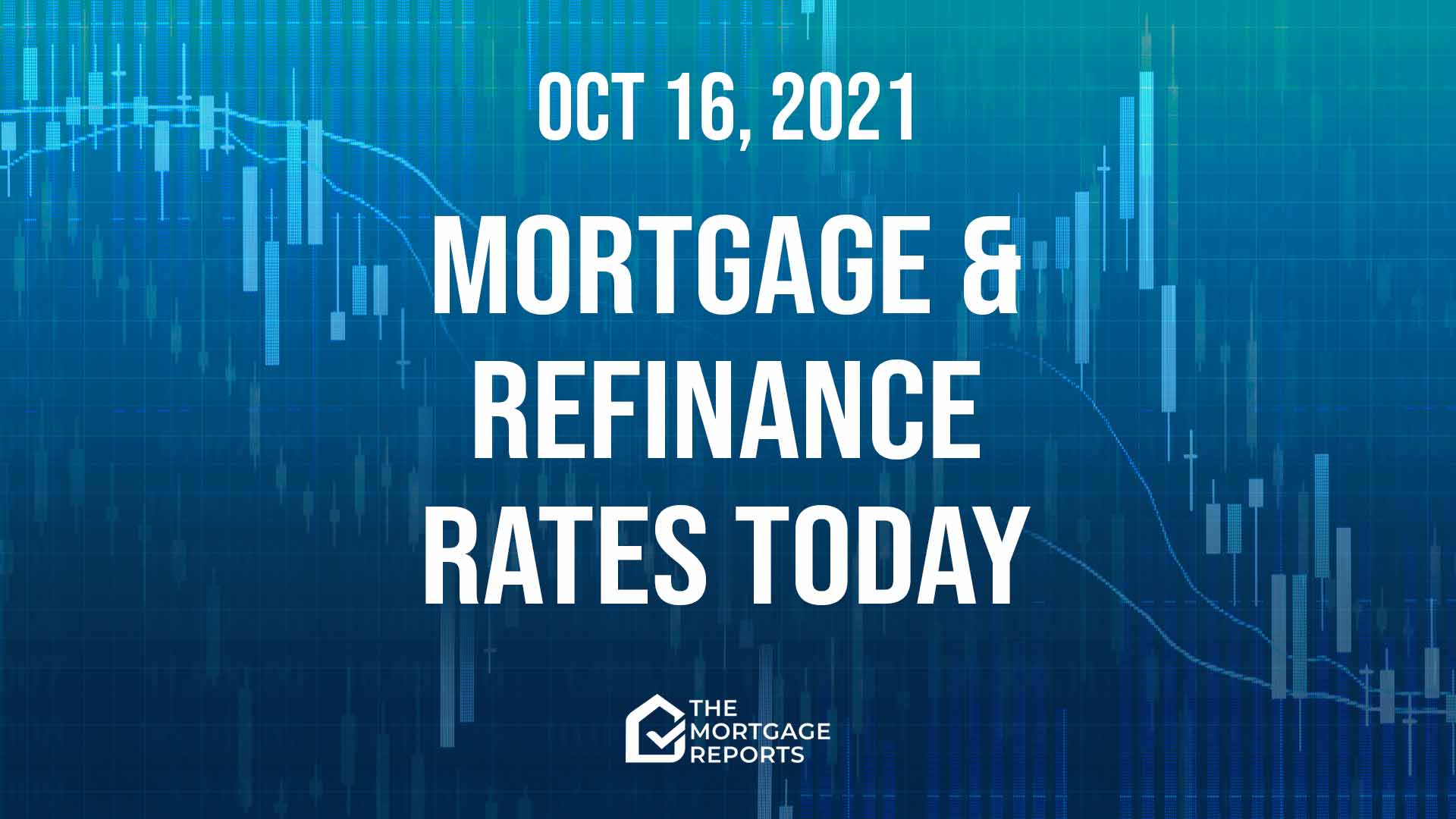
Today’s mortgage and refinance rates
Average mortgage rates edged higher yesterday, ending a brief, two-day period of falls. That day’s rates weren’t at their highest over the last month. But they were close. Still, leaving aside the last year or so, they remain extraordinarily low.
Personally, I suspect that mortgage rates will rise next week and will continue higher for some time. But every upward trend is punctuated by periods of falls. And I can’t be sure we won’t see one of those over the next seven days.
Find and lock a low rate (Oct 16th, 2021)Current mortgage and refinance rates
| Program | Mortgage Rate | APR* | Change |
|---|---|---|---|
| Conventional 30 year fixed | |||
| Conventional 30 year fixed | 3.24% | 3.257% | +0.04% |
| Conventional 15 year fixed | |||
| Conventional 15 year fixed | 2.578% | 2.609% | +0.05% |
| Conventional 20 year fixed | |||
| Conventional 20 year fixed | 2.994% | 3.029% | +0.05% |
| Conventional 10 year fixed | |||
| Conventional 10 year fixed | 2.483% | 2.539% | +0.04% |
| 30 year fixed FHA | |||
| 30 year fixed FHA | 3.185% | 3.946% | +0.03% |
| 15 year fixed FHA | |||
| 15 year fixed FHA | 2.566% | 3.209% | +0.03% |
| 5/1 ARM FHA | |||
| 5/1 ARM FHA | 2.611% | 3.16% | +0.03% |
| 30 year fixed VA | |||
| 30 year fixed VA | 3.012% | 3.204% | +0.03% |
| 15 year fixed VA | |||
| 15 year fixed VA | 2.748% | 3.098% | +0.02% |
| 5/1 ARM VA | |||
| 5/1 ARM VA | 2.524% | 2.382% | +0.03% |
| Rates are provided by our partner network, and may not reflect the market. Your rate might be different. Click here for a personalized rate quote. See our rate assumptions here. | |||
COVID-19 mortgage updates: Mortgage lenders are changing rates and rules due to COVID-19. To see the latest on how coronavirus could impact your home loan, click here.
Should you lock a mortgage rate today?
Even after a couple of worthwhile falls this week, I see little point in continuing to float your rate. Because I reckon that further rises are much more likely than future falls.
But not everyone agrees with me. True, few are predicting falls. But some experts question whether future rises will be as steep as I’m predicting. So, by all means, “do your own research.” After all, that’s the catchphrase for these times.
Anyway, my personal recommendations remain:
- LOCK if closing in 7 days
- LOCK if closing in 15 days
- LOCK if closing in 30 days
- LOCK if closing in 45 days
- LOCK if closing in 60 days
However, with so much uncertainty at the moment, your instincts could easily turn out to be as good as mine — or better. So be guided by your gut and your personal tolerance for risk.
What’s moving current mortgage rates
Let’s skip the Federal Reserve’s tapering plans this week. If you’re a new reader and aren’t sure what those plans are or mean, you can catch up by reading last week’s edition of this weekend report.
Inflation
Instead, let’s turn our attention to inflation. This is important for mortgage rates because those are largely determined by the yields investors can get on a certain type of bond: a mortgage-backed security (MBS). These MBSs give investors a fixed income. And if you were to buy one today, that income would be some way south of 3% a year.
But hang on! Wednesday’s consumer price index (CPI) showed prices rising at 5.4% year over year. And even if you strip out volatile food and energy prices (to get “core CPI”), which we hope — fingers crossed — might calm down, you’re still looking at that inflation measure running at 4% year-over-year.
Now, imagine you’re an investor who’s thinking of buying some MBSs. You’re going to get maybe 2.% income at a time when inflation is running at 5.4%. So your investment’s not just earning zero. It’s actually bringing you a real-terms loss.
Might inflation ease?
And it’s not as if you can expect any immediate relief from higher prices. Also this week, the producer price index and the import price index were published. And neither of them suggested any significant slowing in CPI rises in the near future.
Of course, many economists believe inflation might ease soon. But it’s not a foregone conclusion. Writing yesterday in an e-newsletter for The New York Times, economist Paul Krugman said he was in the lower-inflation-soon camp. But he acknowledged, “the data are sufficiently ambiguous that both sides can claim that the evidence supports their take.”
And he continued:
Why is it so hard to make a call on inflation right now? Because the current economy, still very much shaped by the pandemic, is, to use the technical term, weird. In particular, the standard measures economists use to distinguish between temporary price blips and underlying inflation are telling different stories.
In light of that, what would you, as a potential investor in MBSs, do? If I were you, I’d hang on until MBS prices fell and their yields rose.
And, to some extent, that’s probably already happening in the market. But where do you keep your money while you’re waiting, other than in risky stocks? That’s the quandary facing many actual investors who are seeking safe havens for their cash.
More upward pressure on mortgage rates
Unfortunately, it’s not just inflation and Fed tapering that look set to push mortgage rates higher.
Yesterday’s retail sales figures for September were better than expected. And those suggested that the economic recovery remains on track. Of course, a strong economy almost inevitably means higher rates.
Meanwhile, the COVID-19 pandemic, which has been the underlying cause of the low mortgage rates we’ve seen over the last 18 months or so, is showing signs of easing, at least in America. Since Sept. 13, when the daily number of new cases nationwide was 285,058, new infection rates have been falling consistently. And yesterday that number was down to 98,560, according to The New York Times.
Economic reports next week
We’ve had all this month’s crucial employment and inflation reports over the last couple of weeks. And those are the two measures that are currently obsessing investors. So markets may be relatively quiet next week.
And none of the economic reports listed below is likely to cause much movement in markets unless it includes shockingly good or bad data:
- Monday — September industrial production and capacity utilization
- Tuesday — September building permits and housing starts
- Thursday — September existing home sales and leading economic indicators. Plus weekly new claims for unemployment insurance to Oct. 16
We’re probably in for a quiet week in terms of markets reacting to economic reports.
Find and lock a low rate (Oct 16th, 2021)
Mortgage interest rates forecast for next week
Yes, I reckon mortgage rates might rise again next week. However, every weekly forecast is less reliable than a daily or longer-term one.
With daily ones, you can see how markets are starting the day. And with longer-term ones, you’re looking at trends and weighing probabilities. But anomalies often arise over seven days.
Mortgage and refinance rates usually move in tandem. And a gap that had grown between the two has been largely eliminated by the recent scrapping of the adverse market refinance fee.
And another recent regulatory change has likely made mortgages for investment properties and vacation homes more accessible and less costly.
How your mortgage interest rate is determined
Mortgage and refinance rates are generally determined by prices in a secondary market (similar to the stock or bond markets) where mortgage-backed securities are traded.
And that’s highly dependent on the economy. So mortgage rates tend to be high when things are going well and low when the economy’s in trouble.
Your part
But you play a big part in determining your own mortgage rate in five ways. And you can affect it significantly by:
- Shopping around for your best mortgage rate — They vary widely from lender to lender
- Boosting your credit score — Even a small bump can make a big difference to your rate and payments
- Saving the biggest down payment you can — Lenders like you to have real skin in this game
- Keeping your other borrowing modest — The lower your other monthly commitments, the bigger the mortgage you can afford
- Choosing your mortgage carefully — Are you better off with a conventional, FHA, VA, USDA, jumbo or another loan?
Time spent getting these ducks in a row can see you winning lower rates.
Remember, it’s not just a mortgage rate
Be sure to count all your forthcoming homeownership costs when you’re working out how big a mortgage you can afford. So focus on your “PITI.” That’s your Principal (pays down the amount you borrowed), Interest (the price of borrowing), (property) Taxes, and (homeowners) Insurance. Our mortgage calculator can help with these.
Depending on your type of mortgage and the size of your down payment, you may have to pay mortgage insurance, too. And that can easily run into three figures every month.
But there are other potential costs. So you’ll have to pay homeowners association dues if you choose to live somewhere with an HOA. And, wherever you live, you should expect repairs and maintenance costs. There’s no landlord to call when things go wrong!
Finally, you’ll find it hard to forget closing costs. You can see those reflected in the annual percentage rate (APR) you’ll be quoted. Because that effectively spreads them out over your loan’s term, making that higher than your straight mortgage rate.
But you may be able to get help with those closing costs your down payment, especially if you’re a first-time buyer. Read:
Down payment assistance programs in every state for 2021



